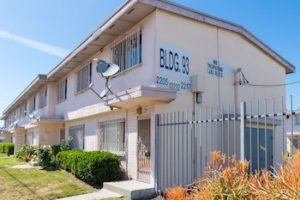
*The Jordan Downs projects were affirmed on this date in 1944. This is a 700-unit public housing apartment complex in Watts, Los Angeles, California. It comprises 103 buildings with townhouse-style units ranging from one bedroom to five. The complex is owned and managed by the Housing Authority of the City of Los Angeles (HACLA). It was originally developed as semi-permanent housing for war workers during World War II.
In the early 1950s, HACLA converted it to public housing, among Watts's last public housing projects to be opened for that purpose. It opened in 1955, shortly after new mayor Norris Poulson ended all new public housing in the city. The development began partially integrated; however, its occupancy rapidly became majority Black, approaching 100% by the mid-1960s. This rapid change occurred for several reasons.
Many of the veterans who still lived in the projects in the early 1950s moved out as they were able to purchase homes. After the war, Blacks, still migrating west, gravitated toward areas like Watts. In addition, restrictive covenants helped channel migrants into Watts and away from nearby suburban cities. The decrease in manufacturing jobs in Los Angeles depressed the area; simultaneously, the concentration of impoverished citizens, combined with a sense of disenfranchisement and indifference or hostility, made crimes committed.
Jordan Downs was one of the flashpoints of the 1965 Watts riots. Like the other housing projects, Jordan Downs benefited relatively little from the influx of federal money and attention that followed the riots. In the seventies and eighties, despair about the post-war model of public housing and declining federal spending in this area further dilapidated this and the other area projects. By the mid-1980s, Jordan Downs was one of the homes of the street gang, the Crips.
In 1989, claiming that HACLA had failed to improve the quality of life at the project, executive director Leila Gonzalez-Correa announced plans to sell the project to a private developer at market value. The plan provided a fresh influx of money while preserving the land as low-income housing. The plan was canceled. The controversy contributed to Gonzalez-Correa's departure from the housing authority at the end of 1989.
In the early 1990s, Jordan Downs witnessed changing demographics of Watts as Latin American tenants began to make inroads into the long-sizeable Black majority at the facility. This transformation, though generally peaceful, was accompanied by occasional tension. The Grape Street Crips were involved in the Watts truce that preceded the 1992 Rodney King riots, and the more general truce agreed to in the wake of the riots.
As a result, Jordan Downs was peaceful in the 1990s. The resurgence of gang violence in the new century, combined with cutbacks in police patrols, has led to a steady increase in gang violence but has decreased rapidly in the late 2000s due to numerous police raids. The complex was featured in the movie Menace II Society, and notable residents included Florence Griffith-Joyner. Jordan Downs is currently under construction, completely transforming the projects into a modern urban village with new apartment complexes, restaurants, retail stores, and parks.